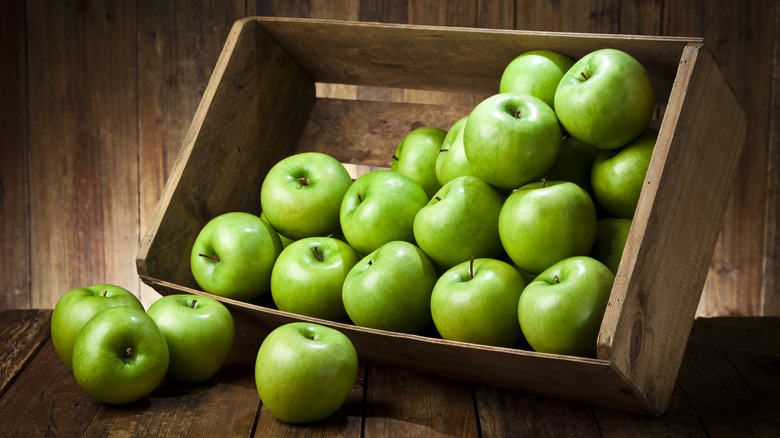Yes, Granny Smith Apples Are Named After A Real Person
While the Red Delicious apple may conjure tempting images of the fruit being plucked from a tree, the Granny Smith apple, with its vibrant green coloring, offers a different kind of enticement. Its touch of tartness and remarkably crisp texture make it a favorite in baking, cheese plates, and even sandwiches. This widely popular fruit is a kitchen staple, thanks to the real Granny Smith who propagated the unique variety.
English emigrant Maria Ann "Granny" Smith is credited with this Australian fruit discovery, when, in a stroke of serendipity, her discarded apple cores sprouted into seedlings in 1868. After discovering the fruit's culinary potential, Granny cultivated this particular variety. Although her apple didn't receive its full accolades until after her death, the "Granny Smith's Seedling" became highly regarded for its extended storage window — it could be picked in March, and kept until November.
The Australian government promoted and exported Granny's apple far and wide. From serving soldiers in WWII to becoming a favorite in American grocery stores, the variety's popularity endured. Today, the Granny Smith is considered the third most popular apple in the world. Though the old saying about an apple a day might be trite, we owe Maria Ann Smith a moment of gratitude for cultivating this fruit for all to enjoy.
Why are Granny Smith apples so versatile?
Peeking out from the delicate lattice of a pie or topped with a sweet, texturally complex crisp, Granny Smith apples have become a baking staple. Maria Ann "Granny" Smith likely appreciated the thick skin and tart flavor of this variety, recognizing its versatility in the kitchen.
One reason Granny Smith apples are so beloved is their suitability for both sweet and savory applications. Bakers love how the texture holds up during cooking, preventing a mushy or mealy result. From a classic apple pie to a tarte tatin, the possibilities are endless.
The slight tartness also complements many savory dishes. Granny Smiths shine in hearty stuffings, pair beautifully with cheese, and even offer a surprisingly delicious tang as secret ingredient in chili.
While the vibrant green color might be a bold contrast to the sea of red apples in the produce aisle, it's more than just the hue that makes the Granny Smith apple a shining jewel. That gift from Down Under offers cooks unmatched culinary versatility.
Does the Granny Smith name add to its appeal?
Some might think food names are arbitrary, but the reality is that choosing a name is more than just randomly picking a word out of a hat. While many famous dishes and foods reference real people, naming fruits can be a little trickier.
Generally, the person, organization, or company that cultivates or breeds a fruit gets to choose its name. Sometimes, the name describes a taste, like the sweetness of a Honeycrisp apple. Other times, the name references the person who discovered the variety. Since the fruit will always bear that name, a good deal of thought goes into the decision.
Today's produce marketing might not have chosen "Granny Smith" for this iconic green-skinned, slightly tart apple. However, the name has become synonymous with warm, comforting baked desserts. New cross-bred varieties, like the Grapple, reflect the influence of modern marketing–appealing to younger demographics with a grape-like tasting apple. Whether the name conjures an image, taste, or sentiment, the classic phrase, "what's in a name?" still applies. These aren't just generic apples in the bunch.


